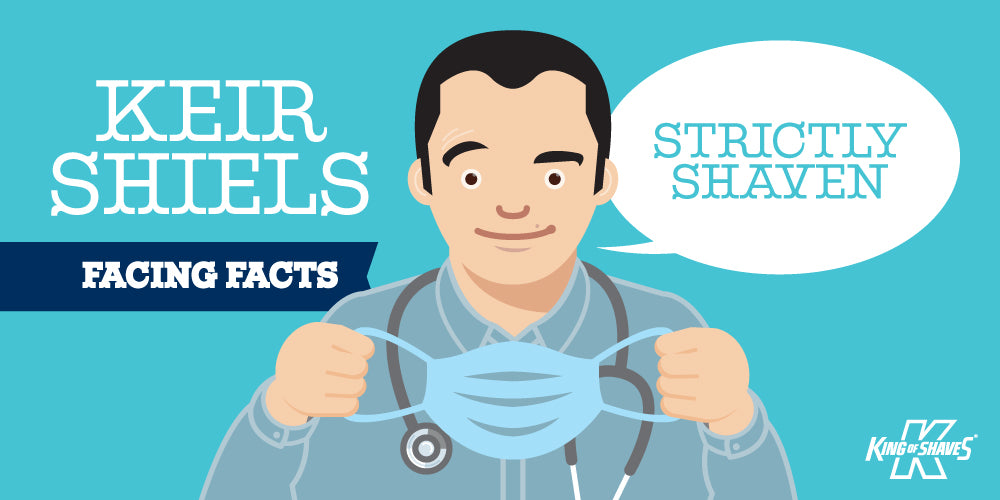
Introducing: Dr. Keir Shiels.
In my first article ‘Why do you shave?’ I looked at the varying reasons why different people might shave. Inspired by that article, and chatting with King of Shaves Founder, Will King, I asked him who he knew who I might interview (turns out he knows quite a few very interesting people!) and whether he could put me in touch with them.
For our first 'Facing Facts' interview I spoke to Dr. Keir Shiels - a London-based paediatrician. We talk about ‘Strictly Come Dancing’, the power of Twitter, his love for gin, and the surprising effect the coronavirus pandemic is having on facial hair in hospitals.
I hope you enjoy!
Jonathan S. Bean

My personal style
In the uniform policy, there’s a degree of smartness that you’re supposed to have as a doctor. 30 years ago doctors were wearing long-sleeved shirts with cufflinks, ties and a white coat over the top. Infection control realised the white coat was pretty much a petri dish that wasn’t being washed, so they got banned. Then the sleeves had to be rolled up and now the tie has come off.
Gradually we’ve ended up with a uniform that is pretty much chinos and a blue and white striped shirt for every male doctor on the ward, if they’re not wearing scrubs.
As a teenager and when I was at university, my hair was a huge thing about me, though you wouldn’t know it now. I guess that’s where the grooming priorities came. You know the way Matt Smith looked in ‘Doctor Who’; that massive quiff,? That was my hair and it was always a big part of who I was.
Then my hair decided it could perform better on its own and we had a divorce. We broke up due to artistic differences and it went off to form its own solo career.
I’m somebody who, if I’m going to make a mistake in a dress code, will always be overdressed rather than underdressed. I would rather dress too smartly for an occasion than too casually.
That’s how I’ve dressed and how I’ve looked since I was a teenager. That is just part of me. I don’t suit casual clothes as well as I suit a jacket. I’m very envious of people who look good in a tracksuit top or who can get away with wearing sports shoes. I think I just look like an idiot in them and always have. With the way I dress, not going out with a stubbly, straggly face has been a part of that.
And a really good shave - like when somebody else is doing it in a barber’s shop - is a great treat now and again.
Coronavirus, PPE, and shaving
Shaving has become a really important topic during the coronavirus pandemic because of PPE (personal protective equipment).
There are two grades of PPE. One is the sort of general medical clothing that you’d wear to get in close to somebody anyway: Some gloves, an apron and the sort of mask you might wear in an operating theatre.
Then there’s the advanced PPE which are sealed masks that go round your nose and mouth. They’ve got to be properly fit-tested as there are several different types and you’ve got to have the correct one for your face shape. They’ve got to go over your mouth and nose with a really good seal.
There’s always been this unwritten rule in medicine - like that old rule in the Navy, that you’re allowed to be clean shaven or have a full beard, but nothing in-between - that you’re allowed a goatee or moustache, but stubble is frowned upon.
Now, a lot of people have suddenly been told to come into work tomorrow, clean shaven, in order to be fit-tested for a mask. People with beards are being told they’re not allowed to have beards anymore, so they are trying to be inventive by seeing how much of a moustache or goatee they are able to leave and get their mask around. People are experimenting with their facial hair in a way they haven’t before, but it’s always hidden behind a mask.
People have been drawing mouths and smiles on masks, particularly in paediatrics, where I work. You’re scary enough to a child when they can see your face and you’re wanting to look in their ear. But when you’re coming at them dressed - at best like a dentist and at worst like Dr No in a hazmat suit - it’s alien and terrifying to them.
It’s difficult enough to interact with a three year old at the best of times. We can’t blow bubbles at them any more as bubbles are little floating pockets of possible infection, so people are drawing smiles on their masks and doing what they can to try and seem less intimidating.
Paediatrics
Yes, paediatrics is great because you’re dealing with children and they’re fun, funny, silly and unpredictable. And yes, they’re sick, but generally speaking they get better very quickly. Even when they’ve got very serious things wrong with them, their recovery rates are much better than adults.
It’s also really broad. I can’t imagine what it must be like to be a kidney specialist and only do kidneys for your entire career. I’m dealing with a kidney problem in one patient, a brain problem in the next, and a foot problem after that. It’s that variety that keeps me going.
I’ve got a very low boredom threshold and I like doing lots of different things. I love the unpredictability of paediatrics and the variety of ages and presentations is incredible. The smallest patient I ever had would have weighed 420 grams, and the biggest was pushing seven feet. It’s like being a vet, just with shorter gloves.
Every day is a school day
The thing that is fascinating about working in medicine is how rapidly things change. Keeping up to date with medicine is impossible.
When I was a medical student, from 2005 to 2009, Hepatitis-C was incurable and it’s now curable. HIV has gone from being, in 1984, the plague that was going to kill everybody that contracted it, to being a totally treatable disease that allows people to live a completely normal life.
Think of a radiologist that qualified in the 1960s when they had X-rays and that was it. Now, they’ve got CT scans, ultrasound probes, MRI, and can see which bit of your brain is lighting up during different thought processes. Everybody’s doctor’s field of medicine will change radically over their lifetime and it’s fascinating.
It’s by having a responsibility for teaching people that you give yourself a responsibility to being up to date. You can’t teach something unless you understand it.
Every patient consultation is, in a sense, a little teaching session. It’s about explaining what’s wrong with somebody and trying to translate the scientific jargon you’ve been taught into layman’s terms that can be understood, a management plan that can be followed and will be remembered.
No, a five year old doesn’t need to know about the ins and outs of asthma, but their parents do need to know what to do in an emergency. A doctor has got to be able to impart that information to people at a level that is appropriate to them and will stick with them. My interest in education stems from this.
I also enjoy the public health element. I’ve done some videos for the Huffington Post, for example, answering common questions about babies. Most people have one or only a few babies; I’ve had 15,000. Granted, I’ve not had them for very long and I give them away to someone else, but I know my way around a baby. The behaviours of babies can be very difficult to interpret and I’ve been able to reassure people about some of the things that feel as though they’re a bit weird, but are actually normal.
Before medicine, I’d done a lot of musical theatre. Acting and performance were always my first loves and probably still are. One reason why I gravitated towards paediatrics is you’re allowed to be silly and loud. The only way to get a four year old to trust you, is to join in their games and pretend to be animals. If you get the child on board, you get their parents on board, as they think, “this is someone who can understand my child”. If you only talk to the parent, you never get the child on board. So acting skills are really important in medicine, particularly in paediatrics.
Strictly Tweeting
When I was at university I loved watching ‘Strictly Come Dancing’, so I joined the ballroom dancing classes. I then joined the team and danced competitively for three years at university. It’s the nearest I had to a sport and I fell in love with it.
I was on the BBC programme, ‘Junior Doctors’, where we were followed around the wards. It was great fun and I got onto Twitter because we were told people will be tweeting about the programme and we could reply to them.
Since then, I realised that whenever I was watching ‘Strictly’ I could tweet along. I started pretending I was the fifth judge and I would get my little review of the dance and the score in between the dance finishing and the judges revealing their scores. People started following me because of this and it ended up going round the BBC.
I think Corrie Corfield, who reads the news on Radio 4, was one of the first ones to follow me, and then I had Eddie Mair tweeting me. Before I knew it, Zoe Ball was following me and I was invited to watch ‘It Takes Two’ being filmed. The ‘Strictly’ tweetalong spiralled and now I have around 11,500 followers; mainly from wittering on about ‘Strictly’, medicine and rubbish jokes.
I nearly got into trouble for a tweet.
Adult patients with Covid-19 who are severely breathless do much better when they are nursed on their front rather than on their back. To do this, you need five pillows per patient and they only had one pillow per patient in the A&E department. I was asked to make a request on Twitter, asking for donations of pillows.
I put it out on a Saturday at lunchtime, then went to bed before a night shift. That night, I checked Twitter and had, at that point, 2,800 retweets. People were donating pillows in units of 6, 8, 12, 20 and I deleted the tweet when it reached 4,500 retweets.
The following day there were hundreds of deliveries from online retailers and they filled an entire patient cubicle, top to bottom, door to wall, with pillows. They just kept coming and coming. That is the power of social media.
Gin
Asking me to recommend a gin is like asking someone to choose a favourite child, but these are my three favourites at the moment:
If you’re wanting a gin and tonic, I love ‘Isle of Harris’ and it’s in an absolutely gorgeous, hand-crafted bottle.
‘Roaring Noon 1922’ is only available from The London Gin Club in Soho and they’ve made it from a recipe designed by F. Scott Fitzgerald. It’s 68% alcohol by volume and it’ll knock your teeth out.
‘Monkey 47’ is bonkers. It doesn’t taste like gin, but it does taste incredible.
We’re getting on for summer, though, when you want really clean, light, fresh stuff like ‘Bloom’ and ‘Martin Millers’.
Thank you for talking to us, Keir.
If you'd like to find out more about Keir or follow him on twitter, his website is here and he tweets here.
